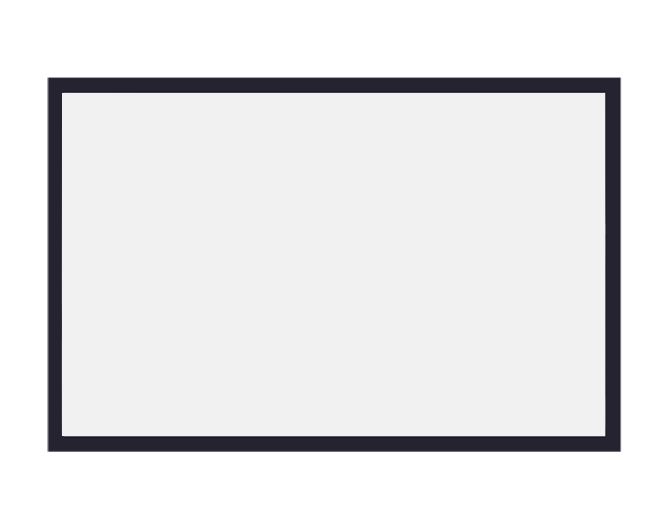From tablets and smartphones to information kiosks, ticket machines, and touch tables, touch technology has become an integral part of modern life. A range of touch technologies exists today, each operating differently—some detect touch through infrared light, others through pressure, and some even through sound waves.
So, which touch technology is the best? The answer depends on the application. Each type has its own advantages and limitations, making it more or less suitable for specific uses.
In this article, we’ll explore the most common single-touch and multi-touch technologies, outlining their key benefits and drawbacks to help you understand which option fits your needs best.
Resistive touch screens operate based on pressure. They are made up of two panels coated with electrically conductive layers, separated by a thin air gap. When pressure is applied—whether by a finger, stylus, or any object—the two layers make contact. The system measures the resistance at that point to determine the exact location of the touch on the screen.
While resistive touch technology is inexpensive and reliable, it is no longer considered cutting-edge compared to modern touchscreen technologies.
Low cost: They are inexpensive to manufacture, making them a budget-friendly option.
Flexible input: Can be operated with a finger, gloved hand, prosthetic, or stylus.
Durable: Resistant to water and dust, suitable for harsher environments.
No multi-touch support: Only one touch point is recognized, limiting functionality for multiple users and gestures like pinch-to-zoom.
Visibility issues: The conductive layers can make the screen difficult to read in bright light or direct sunlight.
Wear and tear: Frequent pressure is required to register touches, which can lead to faster degradation of the screen over time.
Infrared (IR) touchscreens use a frame of infrared emitters and receivers placed around the screen, creating an invisible grid of light across the display surface. When an object or finger interrupts the grid, the system calculates the touch position through triangulation.

Durable and low-pressure: The screen does not need to be pressed for input, reducing wear and tear.
Flexible input: Works with any type of glass, bare fingers, gloves, plastic styluses, or metal objects.
Accurate and responsive: Sensors quickly detect touches, providing precise input.
Cost-effective: Infrared touchscreens are relatively inexpensive compared to other touch technologies.
Light sensitivity: Performance can be affected by strong sunlight or halogen lighting.
Maintenance required: Dust or dirt on sensors may cause malfunctions.
Limited multi-touch quality: While multitouch is supported, it is less accurate than on smartphones.
Potential blind spots: Areas may fail to register touch if the infrared beams and sensors do not fully cover the screen.
Limited object recognition: The system treats any interruption as a touch, so gestures involving rotation or shape recognition are not possible.
This advanced infrared touchscreen works similarly to traditional IR touchscreens, using sensors that emit and receive infrared light to create a “light curtain.” The sensors are positioned behind the glass, allowing the light to travel directly through the pane. When the glass is touched, the disturbance is detected, and the sensors calculate the touch location.
High precision: Ideal for writing with passive pens or styluses.
Automatic distinction: Differentiates between pen, finger, and palm, improving usability for interactive whiteboards.
Pressure detection: Can sense the strength of a finger press, enabling additional interactions such as zooming.
Advanced multitouch: Supports up to 40 simultaneous touch points.
Reliable in various lighting: Works accurately even under different ambient light conditions.
No object recognition: Cannot identify specific objects during multitouch interactions.
Sensitive to contamination: Both capacitive and non-capacitive objects, as well as dirt or grease, can disturb the light grid and trigger false touches.
Limited suitability for multitouch tables: Best used for writing and standard multitouch tasks, but not for complex object-based interactions.
Unlike resistive touchscreens, capacitive touchscreens rely on the electrical properties of the human body for input. Modern PCAP screens feature a wafer-thin conductive grid behind the glass panel that projects a capacitive field through the pane. When a finger or other electrically conductive object touches the glass, the capacitance at the intersection points changes, allowing the system to calculate the touch location.
PCAP technology is now the most widely used touchscreen type, powering virtually all tablets, smartphones, and many large-format interactive displays.
Highly accurate and responsive: Excellent for fast, precise input.
Supports multitouch and gestures: Can handle multiple touch points, object recognition, and gesture-based controls.
Robust design: The sensor is protected behind the glass, making the display durable.
Unaffected by ambient light: Works consistently regardless of lighting conditions.
High display quality: Maintains excellent screen contrast and clarity while providing accurate input.
Higher cost: High-quality PCAP touchscreens are generally more expensive than other technologies.
Sensitivity to conductive materials: Water, rain, or other conductive substances can trigger unintended inputs.
Limited with gloves: Non-conductive gloves can prevent touch input, making them less ideal for outdoor or industrial environments.
The short answer is: it depends. Choosing the right touchscreen depends on several factors, including:
Budget
Intended use and environment
Need for expansion or additional functionality
Multi-touch versus single-touch requirements
Pen or object recognition
Orientation of the display (vertical wall-mounted or horizontal table)
Changing lighting or environmental conditions
Capacitive touch technology, particularly projected capacitive (PCAP), has advanced significantly in recent years. Its widespread adoption in mobile devices has driven improvements in performance, accuracy, and cost-efficiency. With the integration of artificial intelligence, capacitive screens are becoming increasingly precise and capable of new input possibilities, expanding the potential use of touch surfaces.
For applications requiring horizontal use, multi-touch, and object recognition, PCAP touchscreens remain the most robust solution. They also deliver vivid visuals and perform reliably under various lighting conditions.
If you’re still unsure which touchscreen technology is ideal for your project, consulting with an expert can help you select the best option to meet your needs.
Previous: None
Next: None
Comments
Please Join Us to post.
0